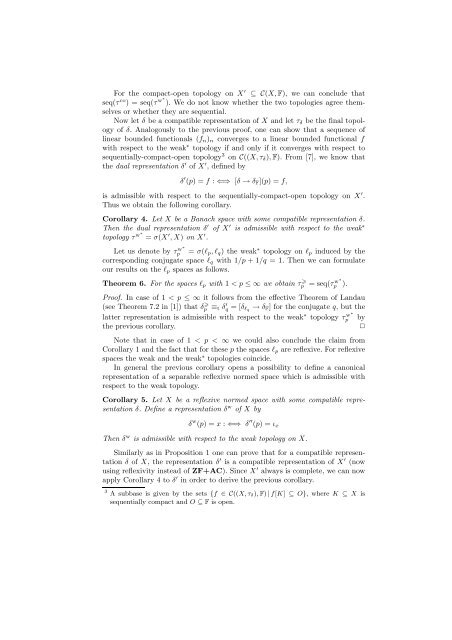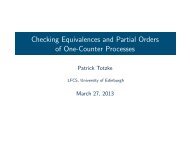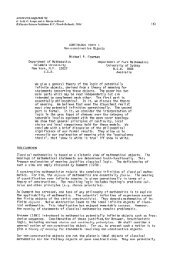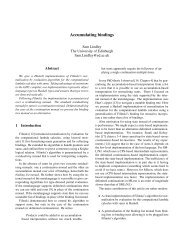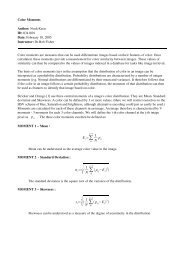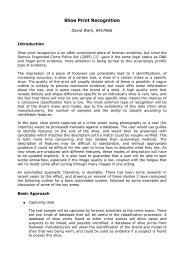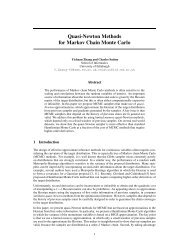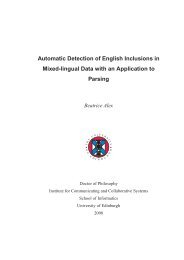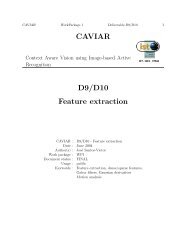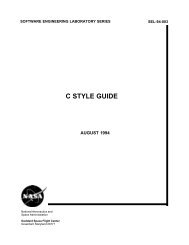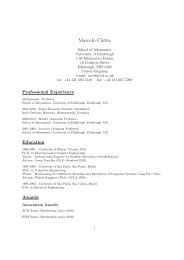View - School of Informatics - University of Edinburgh
View - School of Informatics - University of Edinburgh
View - School of Informatics - University of Edinburgh
Create successful ePaper yourself
Turn your PDF publications into a flip-book with our unique Google optimized e-Paper software.
For the compact-open topology on X ′ ⊆ C(X, F), we can conclude that<br />
seq(τ co ) = seq(τ w∗ ). We do not know whether the two topologies agree themselves<br />
or whether they are sequential.<br />
Now let δ be a compatible representation <strong>of</strong> X and let τ δ be the final topology<br />
<strong>of</strong> δ. Analogously to the previous pro<strong>of</strong>, one can show that a sequence <strong>of</strong><br />
linear bounded functionals (f n ) n converges to a linear bounded functional f<br />
with respect to the weak ∗ topology if and only if it converges with respect to<br />
sequentially-compact-open topology 3 on C((X,τ δ ), F). From [7], we know that<br />
the dual representation δ ′ <strong>of</strong> X ′ , defined by<br />
δ ′ (p) = f : ⇐⇒ [δ → δ F ](p) = f,<br />
is admissible with respect to the sequentially-compact-open topology on X ′ .<br />
Thus we obtain the following corollary.<br />
Corollary 4. Let X be a Banach space with some compatible representation δ.<br />
Then the dual representation δ ′ <strong>of</strong> X ′ is admissible with respect to the weak ∗<br />
topology τ w∗ = σ(X ′ ,X) on X ′ .<br />
Let us denote by τp<br />
w∗ = σ(l p ,l q ) the weak ∗ topology on l p induced by the<br />
corresponding conjugate space l q with 1/p + 1/q = 1. Then we can formulate<br />
our results on the l p spaces as follows.<br />
Theorem 6. For the spaces l p with 1 < p ≤ ∞ we obtain τ p = seq(τ w∗<br />
p ).<br />
Pro<strong>of</strong>. In case <strong>of</strong> 1 < p ≤ ∞ it follows from the effective Theorem <strong>of</strong> Landau<br />
(see Theorem 7.2 in [1]) that δp ≡ t δ q ′ = [δ lq → δ F ] for the conjugate q, but the<br />
latter representation is admissible with respect to the weak ∗ topology τp<br />
w∗ by<br />
the previous corollary.<br />
✷<br />
Note that in case <strong>of</strong> 1 < p < ∞ we could also conclude the claim from<br />
Corollary 1 and the fact that for these p the spaces l p are reflexive. For reflexive<br />
spaces the weak and the weak ∗ topologies coincide.<br />
In general the previous corollary opens a possibility to define a canonical<br />
representation <strong>of</strong> a separable reflexive normed space which is admissible with<br />
respect to the weak topology.<br />
Corollary 5. Let X be a reflexive normed space with some compatible representation<br />
δ. Define a representation δ w <strong>of</strong> X by<br />
δ w (p) = x : ⇐⇒ δ ′′ (p) = ι x<br />
Then δ w is admissible with respect to the weak topology on X.<br />
Similarly as in Proposition 1 one can prove that for a compatible representation<br />
δ <strong>of</strong> X, the representation δ ′ is a compatible representation <strong>of</strong> X ′ (now<br />
using reflexivity instead <strong>of</strong> ZF+AC). Since X ′ always is complete, we can now<br />
apply Corollary 4 to δ ′ in order to derive the previous corollary.<br />
3 A subbase is given by the sets {f ∈ C((X, τ δ ), F) | f[K] ⊆ O}, where K ⊆ X is<br />
sequentially compact and O ⊆ F is open.


